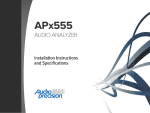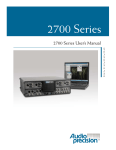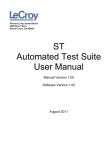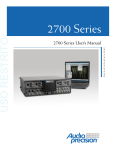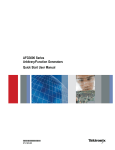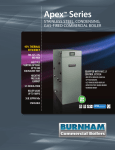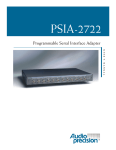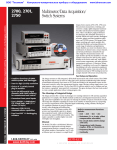Download Untitled
Transcript
APx515 audio analyzer Installation Instructions and Specifications model APx515 October, 2013 Copyright © 2011–2013 Audio Precision, Inc. All rights reserved. Printed in the United States of America. No part of this manual may be reproduced or transmitted in any form or by any means, electronic or mechanical, including photocopying, recording, or by any information storage and retrieval system, without permission in writing from the publisher. Audio Precision, AP, and APx are trademarks of Audio Precision, Inc. Windows™ is a trademark of Microsoft Corporation. Dolby and the double-D symbol are trademarks of Dolby Laboratories, Inc. DTS is a trademark of DTS, Inc. Audio Precision 5750 SW Arctic Drive Beaverton, Oregon 97005 503-627-0832 800-231-7350 ap.com pn 8211.0278 rev 007 XIII0925143207 Documentation and Support This booklet contains safety information, installation instructions and full specifications for the Audio Precision APx515 audio analyzer. The APx500 User’s Manual Detailed information on the operation of the APx515 analyzer is available from the online Help installed with the APx500 measurement software, and in the APx500 User’s Manual. The user’s manual is available as a PDF on the APx500 Application Disc and on the Web at ap.com; a hard-copy version can be ordered from Audio Precision or your local distributor. Audio Test Discs These discs and more can be ordered from Audio Precision or your local distributor. • APx-DVD1 is a playable video DVD with menu-driven linear and coded audio test signals for external source use with DVD players. • APx-CD1 is a playable audio CD with linear audio test signals for external source use with CD players. • APx-BD1 is a playable Blu-ray Disc with menu-driven high-resolution linear and coded audio test signals for external source use with Blu-ray Disc players. ap.com Visit the Audio Precision Web site at ap.com for APx support information. APx resources are available at ap.com/downloads/apx. You can also contact our Technical Support staff at [email protected], or by telephoning 503-627-0832 extension 4, or 800-231-7350 extension 4 (toll free in the U.S.A.). Safety Safety Information Do NOT service or repair this equipment unless properly qualified. Servicing should be performed only by a qualified technician or an authorized Audio Precision distributor. Do NOT defeat the safety ground connection. This equipment is designed to operate only with an approved threeconductor power cord and safety grounding. Loss of the protective grounding connection can result in electrical shock hazard from the accessible conductive surfaces of this equipment. Do NOT exceed mains voltage ratings. This equipment is designed to operate only from a 50–60 Hz ac mains power source at 100–240 Vac nominal voltage. The mains supply voltage is not to exceed ±10 % of nominal (90–264 Vac). APx515 Installation and Specifications For continued fire hazard protection, fuses should be replaced ONLY with the exact value and type indicated on the rear panel of the instrument and discussed on page 10 of this booklet. The International Electrotechnical Commission (IEC 1010-1) requires that measuring circuit terminals used for voltage or current measurement be marked to indicate their Measurement Category. The Measurement Category is based on the amplitude of transient or impulse voltage that can be expected from the AC power distribution network. This product is classified as Measurement Category I, abbreviated “CAT I” on the instrument front panel. This product should not be used within Categories II, III, or IV. The APx515 measurement terminals are rated for a maximum input of 125 Vpk, 88 Vrms and are intended to be used for the measurement of audio signals only. 1 Chapter 1: Safety Do NOT substitute parts or make any modifications without the written approval of Audio Precision. Doing so may create safety hazards. Using this product in a manner not specified by Audio Precision can result in a safety hazard. This product is for indoor use—Installation Category II, Measurement Category I, pollution degree 2. To clean the enclosure of this product, use a soft cloth or brush to remove accumulated dust. A mild detergent may be used to remove remaining dirt or stains. Do not use strong or abrasive cleaners. Wipe all surfaces with a damp cloth. This unit is supplied with four feet on the bottom surface and four feet on the right side surface. The unit should only be operated while resting on the bottom surface feet. The feet on the right side are provided for convenience and stability when transporting the unit. DO NOT operate the unit while it is sitting on the side feet. Safety Symbols ATTENTION!—This symbol alerts you to important operating considerations or a potential operating condition that could damage equipment. If you see this marked on equipment, refer to the Operator’s Manual or User’s Manual for precautionary instructions. FUNCTIONAL EARTH TERMINAL—A terminal marked with this symbol is electrically connected to a reference point of a measuring circuit or output and is intended to be earthed for any functional purpose other than safety. The following symbols may be marked on the panels or covers of equipment or modules, and are used in this manual: PROTECTIVE EARTH TERMINAL—A terminal marked with this symbol is bonded to conductive parts of the instrument and is intended to be connected to an external protective earthing system. WARNING!—This symbol alerts you to a potentially hazardous condition, such as the presence of dangerous voltage that could pose a risk of electrical shock. Refer to the accompanying Warning Label or Tag, and exercise extreme caution. 2 Disclaimer Audio Precision cautions against using their products in a manner not specified by the manufacturer. To do otherwise may void any warranties, damage equipment, or pose a safety risk to personnel. APx515 Installation and Specifications Chapter 1: Safety APx515 Installation and Specifications 3 4 APx515 Installation and Specifications Installation Software The APx515 audio analyzer system uses the award-winning APx500 measurement software. This is the same software used in the APx525and APx585 analyzer families. PC system requirements The APx500 measurement software requires a personal computer (PC) with the following features and capabilities: • Operating system: Microsoft Windows 8, Windows 7, Windows Vista, or Windows XP Professional (Service Pack 2 or later). • A multi-core processor (at least dual-core) running at a clock speed of at least 2 GHz. Most current processors from Intel and AMD meet these requirements. APx515 Installation and Specifications Note: the Intel Atom processor does not meet our minimum specification. • • • • At least 2 GB of RAM. At least 300 MB of free hard disk space. A CD-ROM optical disc drive. A USB 2.0 port; two are required for optional switcher use. • A color monitor and a video card with at least VGA capabilities. Video resolution of 1024 x 768 or greater is recommended. System performance is sensitive to processor speed; faster processors will yield faster results. 5 Chapter 2: Installation APx500 is data intensive and it is recommended that other data-intensive applications not be run concurrently. This includes Audio Precision’s AP2700, APWIN or ATS. Installation To install the measurement software, insert the APx500 CDROM into the optical drive on the PC and follow the instructions in the installation dialog. NOTE: You must have local administrator rights to install APx500 software. Go to User Accounts in the Windows Control Panel, or check with your network administrator. Running the software without instrument hardware attached NOTE: You must have standard user rights or administrator rights to operate APx500 software. Guest users are not supported. You can launch the APx500 software without instrument hardware attached. When no hardware is detected, APx500 will present you with the following dialog box: Select “Demo Mode.” APx500 will run in demo mode, which allows you to explore the user interface but does not enable any measurement functions. Input data shown in Demo Mode is false data, generated for display only. At first launch, Demo Mode runs simulating attachment to an APx585. To run Demo Mode simulating an APx515 or other instrument, select that option from the Instrument Type menu. Running the software with instrument hardware attached NOTE: You must have standard user rights or administrator rights to operate APx500 software. Guest users are not supported. Connecting the instrument to your PC Before connecting your APx515 instrument to your PC, install the APx500 measurement software as described above. Connecting the instrument prior to software installation may cause Windows to select an incorrect USB driver for the instrument. USB driver selection The measurement software communicates with the APx515 using a USB 2.0 interconnection. Once the software is successfully installed, connect one end of the USB cable to a USB 2.0 port on the PC, and the other end to the PC INTERFACE port on the rear of the APx515. We strongly recommend that you use the USB cable included with your instrument (AP part number CAB-APSI). We have tested other USB cables that perform poorly. Note: Some PCs have optional USB ports on the front of the PC, or on extension brackets on the rear. In many cases these convenience ports have compromised performance due to the extra 6 APx515 Installation and Specifications Chapter 2: Installation cable length within the PC. We recommend using USB ports directly connected to the PC motherboard, typically at the rear of the PC. Connect the APx515 mains power cord to the instrument and to a source of ac mains power. See Setting up the hardware below for more information about mains connections. Turn the instrument on by rocking the mains power switch up to ON ( | ). The mains power switch is located in the power entry module on the rear of the APx515. Windows will detect the presence of the APx515 on the USB port and will open the Hardware Update Wizard to search for the correct software driver. Select “Install the software automatically.” Windows will find the Audio Precision driver software installed with APx500 and connect to the APx515. Launch APx500 by double-clicking on the installed shortcut. With the APx515 connected, you may be asked to update the instrument firmware during the first launch of the measurement software. APx500 will start, and in a short time you will be presented with the opening screen. Refer to the APx500 User’s Manual for more information about making measurements. The APx500 User’s Manual is available as a PDF on the APx500 Application Disc and online at ap.com; a hard-copy version can be ordered from Audio Precision or your local distributor. APx515 Installation and Specifications Setting up the hardware Connecting your instrument to the electrical mains supply The APx515 instrument must be connected to a 50–60 Hz alternating current (ac) electrical mains supply, maximum voltage 250 Vrms. The instrument has been configured at the factory for the expected voltage at its intended destination, as ordered. The voltage setting and fusing arrangement will normally be correct unless the instrument has been transported into another area. The power entry module has a strip of indicator tape showing its mains voltage setting. This tape must be removed before use. You MUST be sure that the APx515 instrument mains power configuration is correct for the electrical mains power supplied in your area. If you are not sure, do not plug the instrument into the mains power. Follow the instructions below to check or change the instrument mains supply voltage selection. The mains power supply is applied to your APx515 instrument through the power entry module located on the rear panel. Before connecting the power cord, confirm that the 7 Chapter 2: Installation input voltage selection and fusing arrangement in the power entry module are correct for your mains power supply. To open the power entry module, refer to Figure 3 and proceed as follows: Figure 2. Detail, power entry module on APx515 instrument rear panel. The mains power switch is to the left. Checking the mains supply voltage configuration The white plastic voltage indicator pin protrudes through one of the four labeled holes in the module cover to indicate the selected input voltage. Figure 2 shows the pin in the second position, indicating 120 V. Check to see that the indicated voltage matches your mains supply voltage. If it does not, change the mains supply voltage configuration as described below. Opening the power entry module Unplug the power cord from the instrument before changing fuses or performing any other operations described in this section. 8 Figure 3. Power entry module door and fuse block. • Remove the mains power supply cord from the power cord connector. • Locate the slot in the module cover door hinge. The hinge is a the left side of the cover door, and the slot in the hinge is visible in the power cord connector cavity. Insert a small screwdriver or similar tool in the slot and pry the cover door hinge outward. The cover door will snap out, and then can be pivoted on its hinge for access to the fuse block assembly and voltage selector card. APx515 Installation and Specifications Chapter 2: Installation Changing the Mains Supply Voltage Configuration • Open the Power Entry Module as described above. • The voltage selector card is a small circuit board fitted with a white plastic indicator pin, installed in a housing on the right side of the Power Entry Module as shown in Figure 4. Pull the voltage selector card straight out of the housing, using narrow pliers to grab the card. Do not use the indicator pin as a handle. connector. The card edge indicating the desired voltage should enter the housing first. • Confirm that the correct fuse or fuse combination is installed for the intended input voltage (refer to the fuse ratings marked on the instrument rear panel). If necessary, change the fuse type as described in the following section. 100V 90° 120V 90° 230V 90° 240V Figure 5. Voltage card selector orientation. Figure 4. Changing the mains power supply voltage. • Close the module the cover door and verify that the indicator pin shows the desired voltage. • Once you have verified that the line voltage selection is correct, connect the power cord from a mains power outlet to the power cord connector on the instrument rear panel. • Orient the selector card so that the desired input voltage is readable at the bottom, shown in Figure 5. Then move the indicator pin to point UP, opposite the indicated voltage. Seat the pin assembly in the notch on the board edge. • Insert the voltage selector card into the housing with the printed side of the card facing toward the mains power APx515 Installation and Specifications 9 Chapter 2: Installation Fuse information The power entry module accommodates two fusing arrangements, as illustrated in Figure 6. 100/120 VAC operation The 100/120 VAC fusing arrangement uses a single type 3AG (0.25" x 1.25") slo-blo fuse. Audio Precision recommends only the following replacement fuse: • 1 each Littelfuse 313 Series, 600 mA 3AG 250 V sloblo glass fuse. 230/240 VAC operation The 230/240 VAC fusing arrangement uses two 5 x 20 mm IEC-approved type T fuses. Audio Precision recommends only the following replacement fuses: • 2 each Littelfuse 213 Series, 315 mA 250 V 5 x 20 mm Time Lag (slo-blo) glass fuses or • 2 each Littelfuse 218 Series, 315 mA 250 V 5 x 20 mm Time Lag (slo-blo) glass fuses. Refer to the label on the instrument rear panel for fuse current ratings. To replace a fuse or change the fusing arrangement, proceed as follows: • Remove the mains power cord from the power cord connector and open the Power Entry Module as described above. • Using narrow pliers, pull the fuse assembly out of the housing. • Change or add the correct fuses as necessary, referring to Figure 6. Refer to the instrument rear panel for the correct fuse electrical current rating. • Insert the fuse assembly in the housing, with the side of the assembly that carries the fuse(s) for your desired fusing arrangement facing into the housing. Press the fuse assembly firmly into the housing. • Confirm that the line voltage selection is correct for your mains voltage and your fusing arrangement. Once you have verified that the line voltage selection is correct, connect the power cord from a mains power outlet to the power cord connector on the instrument rear panel. Changing the fusing arrangement Figure 6. Fuse block orientation for 100/120 VAC and 230/240 VAC operation. 10 APx515 Installation and Specifications Abbreviations, Terms and Symbols used in the following specifications ADC or A/D . . . . . . . . Analog to Digital converter. BW . . . . . . . . . . . . . . . Bandwidth or Measurement Bandwidth, a single number indicates only the upper limit. DAC or D/A . . . . . . . . Digital to Analog converter. DUT . . . . . . . . . . . . . . Device Under Test, the device to which the generator or analyzer is connected. EMC . . . . . . . . . . . . . . Electro-Magnetic Compatibility, usually refers to both emissions (radiated and conducted via AC mains) and susceptibility. FFT . . . . . . . . . . . . . . . Fast Fourier Transform, a mathematical process converting the time domain representation of a signal to the frequency domain. IMD . . . . . . . . . . . . . . . Inter-Modulation Distortion, a measure of non-linearity using a test signal with two or more components. rms . . . . . . . . . . . . . . . Root Mean Square, an equivalent-power expression of signal amplitude. SR . . . . . . . . . . . . . . . . Sample Rate, usually as it applies to the conversion rate of A/D and D/A converters. THD . . . . . . . . . . . . . . Total Harmonic Distortion, rms summation of d2 to d9 (may be bandwidth limited), usually derived from an FFT. THD+N . . . . . . . . . . . . Total Harmonic Distortion plus Noise, an rms measurement of ALL harmonics, spurious signals, hum, and noise within a specified bandwidth. Typical or Typ . . . . . . . A characteristic that is not guaranteed, usually due to a practical limitation in testing or metrology. [ ] . . . . . . . . . . . . . . . . Bracket pair, indicates a specification in an equivalent unit, for example: 0.030 dB [0.35%] or 10.61 Vrms [30.0 Vpp]. + . . . . . . . . . . . . . . . . . Bold plus symbol, indicates rms summation (square-root of the sum of the squares) instead of arithmetic summation. ≈ . . . . . . . . . . . . . . . . . Double tilde, indicates an approximate or nominal numerical value (or range of values) that may vary from unit to unit. Abbreviations, Terms and Symbols 11 12 Abbreviations, Terms and Symbols Specifications APx515 audio analyzer with APx500 v3.4 or higher measurement software October 2013 NP0020.00014 r004 Characteristic Specifications Supplemental Information ANALOG GENERATOR Number of Channels 2, independent amplitude control Waveforms Sine, sine split frequency, sine split phase, sine+DC offset, continuously swept-sine, noise, IMD test signals, multi-tone, wave file playback Sine Characteristics Frequency Range (Fs) Frequency Accuracy Amplitude Range Amplitude Accuracy, 1 kHz Flatness (1 kHz ref) Fs = 10 Hz to 20 kHz Fs = 20 kHz to 50 kHz Fs = 50 kHz to 80 kHz Residual THD+N1,2 Fs = 20 Hz–20 kHz Non-Harmonic Content Phase Offset Range (Split Phase) 2 Hz to 80.1 kHz Setting resolution is typically 45 µHz ±(0.0003% + 100 μHz) 0 to 16.00 Vrms [45.2 Vpp], balanced; 0 to 8.00 Vrms [22.6 Vpp], unbalanced ±0.05 dB [±0.58%] ±0.010 dB ±0.030 dB ±0.10 dB (–102 dB + 1.4 µV), 20 kHz BW –179.999 to +180.000 deg APx515 Installation and Specifications Typically <0.005 dB. Typically <-110 dB when Fs ≤75 kHz, increasing to ≈-55 dB at Fs =80 kHz 13 Characteristic DC Offset Range Residual DC Offset Specifications Supplemental Information ±12.00 Vdc balanced; ±6.00 Vdc unbalanced ≤0.25% of Vrms setting [≤0.09% of Vpp setting] + 100 μV DC offset limits maximum ac signal Noise Characteristics Shape Amplitude Range White (<5 Hz to >80 kHz), Pink (<10 Hz to >80 kHz), IEC 60268-1 or BS EN 50332-1 0 to 45.2 Vpp, balanced; 0 to 22.6 Vpp, unbalanced Amplitude calibration is approximate IMD Test Signals (requires option AML) SMPTE & MOD LF Tone Range HF Tone Range Mix Ratio (LF:HF) Amplitude Range Amplitude Accuracy Residual IMD1,2,3 40 Hz to 1 kHz 2 kHz to 20 kHz 10:1, 4:1 or 1:1 0 to 45.2 Vpp, balanced; 0 to 22.6 Vpp, unbalanced. ±0.06 dB [±0.70%] ≤0.0025% [-92 dB], 4:1 mix ratio Tone Pair Mean Range Tone Pair Difference Range 2.5 kHz to 20 kHz 80 Hz to 2.0 kHz Amplitude Range 0 to 45.2 Vpp, balanced; 0 to 22.6 Vpp, unbalanced. ±0.06 dB [±0.70%] 0.0010% [–100 dB] DFD Amplitude Accuracy Residual IMD1,2,3 HF tone must be 6 • LF tone. 4:1 maximum with SMPTE signal. Fmean = (F1 + F2)/2. Fdiff = |F2 - F1| Fmean must be ≥6 • Fdiff Multitone, Wave File Playback (requires option HST) Sample Rate Range (SR) Maximum File Size Amplitude Range 14 8 kS/s to 108 kS/s, and 175 kS/s to 192 kS/s 32 MSample. 0 to 45.2 Vpp, balanced; 0 to 22.6 Vpp, unbalanced. Operation from 109 kS/s to 175 kS/s is possible, but with degraded flatness .Wav file must peak at digital full scale to obtain selected amplitude APx515 Installation and Specifications Characteristic Specifications Flatness (1 kHz ref) SR = 175 kS/s to 192 kS/sec SR = 8 kS/s to 108 kS/s Typically <0.012 dB to 20 kHz Typically <0.04 dB to 20 kHz; max frequency limited to ≈0.45 • SR Typically <–100 dB Spurious Content Output Equalization Supplemental Information Arbitrary 30-pole output filter, scaled so the maximum gain is –1 dB. Source Resistance (Rs) Balanced Unbalanced Common Mode Test Selectable 100 ±1% or 600 ±1%. Selectable 50 ±1.5% or 600 ±1%. Same as Balanced selections Grounded, symmetrical Electronically floating, 0.3 Vpk max; bnc shield to ground ≈10-17 || 22nF Max Output Current Typically >50 mA peak, 50 mA dc Reverse Overload Protection Up to 30 W Output Related Crosstalk1 (–120 dB + 1 µV) to 20 kHz ANALOG ANALYZER Number of Channels 2, independently auto-ranging. Maximum Rated Input 125 Vpk, 120 Vdc any input to ground; 0.5 Vpk for unbalanced bnc shields Max ADC sample rate = 192 kS/s Input Impedance Balanced Unbalanced 100 k || 230 pF, each side to gnd 100 k || 230 pF to bnc shield Input Termination Selectable 600 ±1%, 1.5 W max. Input Coupling Selectable DC or AC Input Ranges 250 mVrms to 80 Vrms, 10 dB steps APx515 Installation and Specifications Electronically floating, 0.5 Vpk max; bnc shield to ground ≈500Ω || 22nF Termination automatically opens in the 80 V range. Typically <0.5 μA bias current with DC coupling, typically <0.03 dB roll-off at 20 Hz with AC coupling Maximum ac signal is ≈88 Vac unbal, 115 Vac bal, in the 80V range 15 Characteristic Specifications Supplemental Information Max common mode signal range: Common Mode Rejection4 250 mV, 800 mV, 2.5 V ranges 8 V range 25 V range 80 V range Input Related Crosstalk 80 dB, 5 Hz to 5 kHz; 70 dB, 5 kHz to 20 kHz. 50 dB, 5 Hz to 20 kHz 50 dB, 5 Hz to 20 kHz 45 dB, 5 Hz to 20 kHz (–120 dB + 0.3 µV) to 20 kHz ±6 Vpk ±12 Vpk ±60 Vpk ±120 Vpk Rs 600 Level (Amplitude) Measurement Range Balanced or bridging input Unbalanced input Accuracy (1 kHz) Flatness (1 kHz ref, DC coupling) 10 Hz to 20 kHz 20 kHz to 50 kHz 50 kHz to 80 kHz < 1 µV to 115 Vrms < 1 µV to 85 Vrms ±0.05 dB [±0.60%] ±0.010 dB ±0.030 dB ±0.10 dB Residual Noise (inputs shorted) 1.4 µVrms, 20 kHz BW Typically < 0.005 dB. Typically < 8.0 nV/√Hz at 1 kHz THD+N Measurement Fundamental Range Measurement Range Accuracy Residual THD+N1,2 20 Hz–20 kHz fundamentals 16 5 Hz to > 50 kHz 0 to 100% ±0.5 dB (–102 dB + 1.4 µV), 20 kHz BW APx515 Installation and Specifications Characteristic Specifications Supplemental Information High-Pass Low-Pass5 5 Hz to 500 Hz, or None 1 kHz to the selected BW setting, or None 1 Hz steps 100 Hz steps; very sharp roll-off characteristic exceeds AES-17. Weighting A-wt, B-wt, C-wt, CCIR-1k, CCIR-2k, CCITT, C-message, 50 μs or 75 μs de-emph (with and without A-wt), or None Weighting filter is cascaded with the high-pass and low-pass bandwidth limiting filters Level & THD+N Filters IMD Measurement Test Signal Compatibility SMPTE & MOD DFD IMD Measured SMPTE MOD DFD Measurement Range Accuracy Residual IMD1,2,3 SMPTE & MOD DFD Any combination of 40 Hz–1 kHz (LF) HF tone must be 6 • LF tone. and 2 kHz–20 kHz (HF), mixed in any ratio from 1:1 to 10:1 (LF:HF) Any two-tone combination with mean Fmean = (F1+F2)/2, Fdiff = |F2–F1|. frequency of 2.5 kHz–50 kHz and a Fmean must be 6 • Fdiff difference frequency of 80 Hz–2.0 kHz Amplitude modulation of HF tone. d2, d3, d2+d3, or d2+d3+d4+d5 d2, d3, d2+d3, or d2+d3+d4+d5 0 to 20% ±0.5 dB Measurement BW is typ. 40–500 Hz. Use “d2+d3” for measurements per IEC 60268 Use “d2+d3” for measurements per IEC 60268 ≤-92 dB [0.0025%], 4:1 mix ratio ≤-100 dB [0.0010%] Frequency Measurement Range Accuracy Resolution 5 Hz to 90 kHz ±0.0003% [3 ppm] 6 digits APx515 Installation and Specifications Vin must be 5 mV. 17 Characteristic Specifications Supplemental Information –90 to +270, ±180, or 0 to 360 deg ±0.2 deg, 5 Hz to 5 kHz; ±0.8 deg, 5 kHz to 20 kHz; ±2.0 deg, 20 kHz to 50 kHz 0.001 deg Vin must be 5 mV with dc coupling, both channels. Accuracy degrades below 50 Hz with ac coupling. 0.25 V to 80 V, 10 dB steps ±120 Vdc maximum in 80 V range Phase Measurement Ranges Accuracy Resolution DC Voltage Measurement Input Ranges Accuracy 250 mV and 800 mV ranges 2.5 V-80 V ranges Normal Mode Rejection ±(0.7% reading + 1 mV) ±(0.7% reading + 0.1% range) Typically > 90 dB, 20 Hz to 20 kHz. DIGITAL I/O DIGITAL OUTPUT RELATED: Formats Electrical, unbalanced Electrical, balanced Optical Sample Rate (SR) Range SPDIF-EIAJ per IEC60958, Output R is nominally 75 0.50 Vpp or 1.00 Vpp ±10% into 75 AES-EBU per AES3-1992, Output R is nominally 110 5.00 Vpp ±10% into 110 Toslink® 22 kS/s to 216 kS/s Sample Rate (SR) Accuracy ±0.0003% [3 ppm] Channel Status Bits Full implementation per IEC-60958 User Bits Fully settable Validity Flag Residual Electrical Optical 18 Automatically set or manual override, hex or plain English Hex Set to 0 Jitter1,6 Typically < 1.5 ns Typically < 2.5 ns, SR 96 kS/s APx515 Installation and Specifications Characteristic Specifications EMBEDDED OUTPUT SIGNAL RELATED: Sine, sine split frequency, sine split Waveforms phase, sine+DC offset, continuously swept-sine, square-wave, noise, IMD signals, multi-tone, constant value, walking ones/zeros, bittest random, wave file playback Supplemental Information 8–24 bit word width, triangular PDF dither. Sine Characteristics Frequency Range Flatness1 Offset Range Harmonics & Spurious1,6 5 Hz to 0.499 • SR To maximum digital code [±1D] Typically <0.001 dB Offset limits maximum ac signal Typically <–140 dBFS Square Characteristics Frequency Range (Fq) 10 Hz to SR / 6 Even Harmonic, Spurious Content Only specific values are allowed: Fq = SR / N where N is an even integer ≥6 Typically <-140 dBFS Noise Characteristics Shape IMD Test Signals SMPTE & MOD LF Tone Range HF Tone Range Mix Ratio (LF:HF) Residual IMD1,6 DFD Tone Pair Mean Range Tone Pair Difference Range White (<5 Hz to 0.499 • SR), Pink (<10 Hz to 0.45 • SR), IEC 60268-1 or BS EN 50332-1 40 Hz to 1 kHz 2 kHz to (0.499 • SR) or 20 kHz, whichever is lower 10:1, 4:1 or 1:1 2.5 kHz to (0.499 • SR – Fmean / 2) or 20 kHz, whichever is lower 80 Hz to 2.0 kHz Residual IMD1,6 APx515 Installation and Specifications HF tone must be 6 • LF tone. Typically <–140 dBFS Fmean = (F1 + F2)/2. Fmean = (F1+F2)/2, Fdiff = |F2–F1|. Fmean must be 6 • Fdiff Typically <–150 dBFS 19 Characteristic Specifications Supplemental Information Multitone, Wave File Playback Sample Rate (SR) Maximum File Size Flatness (1 kHz ref) Spurious Content 8 kS/s to 216 kS/s 32 MSample. Typically <0.001 dB to 0.499 • SR Typically <–140 dB DIGITAL INPUT RELATED: Formats Electrical, unbalanced Electrical, balanced Optical Sample Rate Range (SR) SPDIF-EIAJ per IEC60958, 10 Vpp. AES-EBU per AES3-1992, 10 Vpp. Toslink® 22 kS/s to 216 kS/s Input R is nominally 75 Input R is nominally 110 Typically locks down to 16 kS/s EMBEDDED INPUT SIGNAL RELATED: Level (Amplitude) Measurement Measurement Range Accuracy (1 kHz) Flatness1 < –120 dBFS to +3 dBFS Typically < 0.001 dB Typically <0.001 dB Typically <–140 dBFS Residual Noise1 THD+N Measurement Fundamental Range Measurement Range Accuracy Residual THD+N1, 7 5 Hz to 0.49 • SR or 50 kHz, whichever is lower 0 to 100% ±0.5 dB Tuning can be set to track measured frequency, generator setting or fixed Q=2.6 typically Typically <–140 dBFS Level & THD+N Filters 20 High-Pass Filter Low-Pass Filter5 5 Hz to 500 Hz, or None 1 kHz to 97.2 kHz, or None Weighting A-wt, B-wt, C-wt, CCIR-1k, CCIR-2k, CCITT, C-message, 50 μs or 75 μs de-emph (with and without A-wt), or None 1 Hz steps 100 Hz steps; very sharp roll-off characteristic exceeds AES-17 Weighting filter is cascaded with the high-pass and low-pass bandwidth limiting filters APx515 Installation and Specifications Characteristic Specifications Supplemental Information Any combination of 40 Hz–1 kHz (LF) and 2 kHz–20 kHz (HF), mixed in any ratio from 1:1 to 10:1 (LF:HF). Any two-tone combination with mean frequency of 2.5 kHz–50 kHz and a difference frequency of 80 Hz– 2.0 kHz. HF tone must be 6 • LF tone. IMD Measurement Test Signal Compatibility SMPTE & MOD DFD IMD Measured SMPTE MOD DFD Measurement Range Accuracy Residual IMD1, 7 SMPTE & MOD DFD Amplitude modulation of HF tone. d2, d3, d2+d3, or d2+d3+d4+d5 d2, d3, d2+d3, or d2+d3+d4+d5 0 to 20% ±0.5 dB Fmean = (F1+F2)/2, Fdifference = |F2–F1|. Fmean must be 6 • |F2–F1|. Measurement BW is typ. 40–500 Hz. Use “d2+d3” for measurements per IEC-60268. Use “d2+d3” for measurements per IEC-60268 Typically <–140 dBFS Typically <–150 dBFS Frequency Measurement Range Accuracy Resolution <5 Hz to 0.499 • SR ±(0.0003% + 100 μHz) 6 digits Phase Measurement Ranges Accuracy1 Resolution –90 to +270, ±180, or 0 to 360 deg Typically 0.001 deg 0.001 deg APx515 Installation and Specifications 21 Characteristic Specifications Supplemental Information GENERAL/ENVIRONMENTAL Power Requirements 100, 120, 230 or 240 Vac, 50–60 Hz, with safety ground via approved power cord, 75 VA max. Typical operating range is 90–110 Vac (100V), 108–132 Vac (120V), 198–242 Vac (230V), or 216–264 Vac (240V). Temperature Range Operating Storage Humidity 0° C to +45° C –40° C to +75° C 90% to +40° C (non-condensing) Max Operating Altitude 3,000 m Stabilization Time 20 minutes EMC Safety IEC 61326-1:2005 / EN 613261:2006. Complies with EC Council Directives 2004/108/EC and 93/68/ EEC. IEC 61010-1:2001 / EN 610101:2001, CAN/CSA-C22.2 No. 610101-04, and UL Std No. 61010-1 (2nd Edition). Complies with EC Council Directives 2006/95/EC and 93/68/ EEC. Derate max operating temperature to +40°C at altitudes above 2,000 m Allow at least 60 minutes if unit has been stored in a significantly different environment prior to turn on, or if unit is to be calibrated or adjusted Emission and immunity levels are influenced by the shielding performance of interface and signal cables attached to the instrument. EMC compliance was demonstrated using Audio Precision cables Equipment Class I, Installation Category II, Pollution Degree 2, Measurement Category I Dimensions Width Height Depth Weight 22 370 mm (14.55 inches) 86 mm (3.40 inches) 343 mm (13.53 inches) 2U rack mount tray available. Increase by ≈8mm [0.3 inches] if rear panel option keys are installed 4.2 kg [9.1 lbs] APx515 Installation and Specifications Characteristic Specifications Supplemental Information Notes to Specifications 1. 2. 3. 4. 5. 6. 7. System specification including contributions from both generator and analyzer. Generator-only and/or analyzeronly contributions are typically less. Generator load must be 600 balanced or 300 unbalanced for specified performance. Generator dc offset must be off or set to ≤10 mV. Analyzer input must be ≥150 mV for specified performance. Analyzer set to measure "d2+d3" IMD products for MOD and DFD modes. Valid for the balanced input configuration with dc coupling only. With ac coupling, specified performance is invalid below 50 Hz. Maximum low-pass filter frequency is limited by analyzer input bandwidth setting. Sample rate (SR) must be 27 kS/s for specified performance. Jitter analyzer set for 700 Hz highpass response per AES3-1992. Digital generator word width must be set to 24 bits for specified performance; shorter word widths may degrade performance. APx515 Installation and Specifications 23 Characteristic 24 Specifications Supplemental Information APx515 Installation and Specifications
































